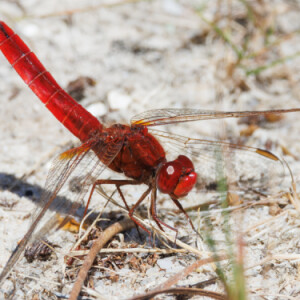Scarlet Darter
I decided yesterday, on a sudden whim, to take a trip to Dorset in search of a couple of rare dragonfly species - but while he encouraged me to go, R felt (and I have to say, I agreed) that it was going to be a bit too far for a day trip. Back in the day I'd have thought nothing of a 300-mile round trip with a few hours of walking and photography thrown in, but these days I'm less confident of my stamina. Luckily, after a bit of hunting around, I managed to book a nearby hotel room for tonight, which will allow me to make a second visit to the site before heading home tomorrow. This morning I had an early appointment in Broadway for a haircut, but as soon as that was out of the way I set off.
Knighton Reserve is a SANG - which essentially means an area that's designed for human leisure but also contains protected wildlife habitat - attached to the privately-owned Silverlake Estate near Dorchester. Owing to sketchy signage, I initially drove straight past the access road and car park, and wound up at the Silverlake Estate offices, but the staff there were extremely helpful, and soon put me back on track. Within seconds of reaching the lake edge, where there were already six or eight other photographers wandering about, I spotted a small dragonfly that was far too red to be anything other than one of my target species, and a helpful local confirmed that it was a Scarlet Darter.
Some of the other photographers then pointed out this specimen, basking on an exposed chalk face, and told me that it was my second target, the Red-veined Darter, but I've since established that they were wrong, and this is also a Scarlet Darter. Male Red-veined Darters have two-tone eyes (red above and blue below) and a pale diagonal stripe on the side of the thorax, and after carefully examining all today's photos I now know that I didn't manage to get one on camera this afternoon - so I'll be concentrating on trying to rectify that in the morning.
The British Dragonfly Society, along with Smallshire & Swash, call this the Scarlet Darter, but not everyone agrees with them. Apart from the White-faced Darter (Leucorrhinia dubia, which would better be called a whiteface, along with other members of its genus), all other UK darters fall within the large genus Sympetrum, which also encompasses the North American meadowhawks. This dragon, on the other hand, is one of only two representatives of the genus Crocothemis that can be found in Europe, and the only one that regularly makes it across the Channel into the UK. Other sources, including Brooks & Cham, refer to it as the Scarlet Dragonfly, and some people call it the Broad Scarlet - the latter of which names will make more sense if you look at my second image, which shows a different male in a semi-obelisk position that displays his broad, flattened abdomen. (That second photo would definitely have made it to top spot if I'd managed to exclude the annoying tuft of grass, but these little dragons are fast and flighty, and if you come one step too close to them, they're gone before you even realise they've taken off.)
Size-wise, the Scarlet Darter is almost exactly the same size as a Common Darter - that is, about 4cm in overall length, with a hindwing nearing 3cm long - but apart from that similarity, the two look very different. A male Common Darter is much drabber than this: his eyes, legs, and the top of his thorax are brown, he has an orangey-red abdomen (darkening with age to - you guessed it - brown), and his wings are essentially clear, with just a small area of yellow at their bases. A male Ruddy Darter is smaller and more slender, and while he's a better match colour-wise, he's nowhere near as vivid as a Scarlet Darter. Having watched several specimens zipping around the lake this afternoon among much bigger dragons, I can tell you that whenever one goes past it's that bright blood red colour that pulls your eye.
The Scarlet Darter is still regarded as a rare vagrant to the UK, though some of my informants at Knighton believe that it may actually be resident there. Certainly there are a number of accepted records of the species at the same site in 2024, and as several people said that they'd seen at least one pair flying in tandem earlier today, I think it's quite possible that they're right.


Comments
Sign in or get an account to comment.


